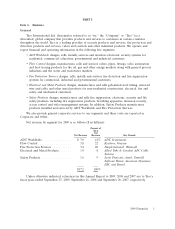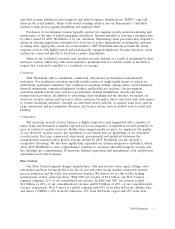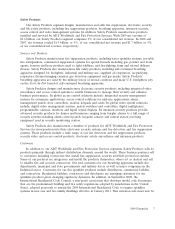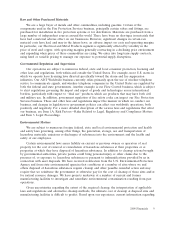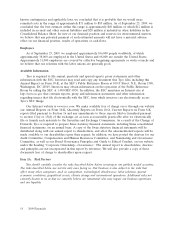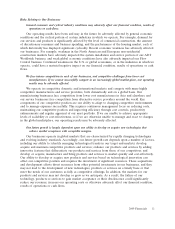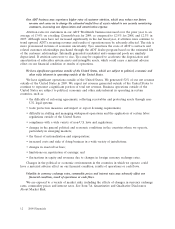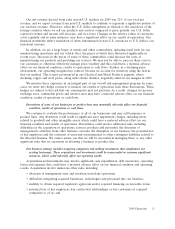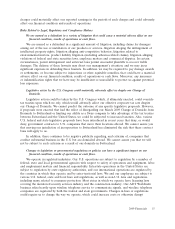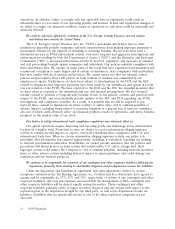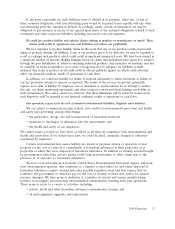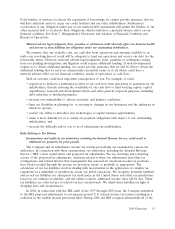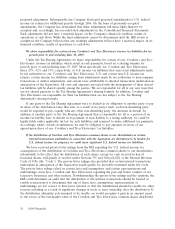ADT 2009 Annual Report Download - page 103
Download and view the complete annual report
Please find page 103 of the 2009 ADT annual report below. You can navigate through the pages in the report by either clicking on the pages listed below, or by using the keyword search tool below to find specific information within the annual report.Risks Relating to Our Businesses
General economic and cyclical industry conditions may adversely affect our financial condition, results of
operations or cash flows.
Our operating results have been and may in the future be adversely affected by general economic
conditions and the cyclical pattern of certain industries in which we operate. For example, demand for
our services and products is significantly affected by the level of commercial construction, the amount
of discretionary consumer and business spending, and the performance of the housing market, each of
which historically has displayed significant cyclicality. Recent economic weakness has adversely affected
our businesses. For example, weakness in the North American and European non-residential
construction markets have adversely impacted the system installation and service portion of our ADT
Worldwide business, and weak global economic conditions have also adversely impacted our Flow
Control business. Continued weakness in the U.S. or global economies, or in the industries in which we
operate, could have a material negative impact on our financial condition, results of operations or cash
flows.
We face intense competition in each of our businesses, and competitive challenges from lower cost
manufacturers. If we cannot successfully compete in an increasingly global market-place, our operating
results may be adversely affected.
We operate in competitive domestic and international markets and compete with many highly
competitive manufacturers and service providers, both domestically and on a global basis. Our
manufacturing businesses face competition from lower cost manufacturers in Asia and elsewhere and
our service businesses face competition from alternative service providers around the world. Key
components of our competitive position are our ability to adapt to changing competitive environments
and to manage expenses successfully. This requires continuous management focus on reducing costs,
maintaining our competitive position and improving efficiency through cost controls, productivity
enhancements and regular appraisal of our asset portfolio. If we are unable to achieve appropriate
levels of scalability or cost-effectiveness, or if we are otherwise unable to manage and react to changes
in the global marketplace, our operating results may be adversely affected.
Our future growth is largely dependent upon our ability to develop or acquire new technologies that
achieve market acceptance with acceptable margins.
Our businesses operate in global markets that are characterized by rapidly changing technologies
and evolving industry standards. Accordingly, our future growth rate depends upon a number of factors,
including our ability to: identify emerging technological trends in our target end-markets; develop,
acquire and maintain competitive products and services; enhance our products and services by adding
innovative features that differentiate our products and services from those of our competitors; and
develop or acquire, manufacture and bring products and services to market quickly and cost-effectively.
Our ability to develop or acquire new products and services based on technological innovation can
affect our competitive position and requires the investment of significant resources. These acquisitions
and development efforts divert resources from other potential investments in our businesses, and they
may not lead to the development of new technologies, products or services on a timely basis or that
meet the needs of our customers as fully as competitive offerings. In addition, the markets for our
products and services may not develop or grow as we anticipate. As a result, the failure of our
technology, products or services to gain market acceptance or their obsolescence could significantly
reduce our revenues, increase our operating costs or otherwise adversely affect our financial condition,
results of operations or cash flows.
2009 Financials 11


